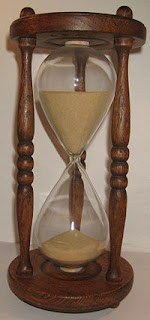 Listen, although I'm concerned, I'm not going to get involved, here, in the current hoo-ha about Daylight Savings Time, Congress, and the effects on our planet.
Listen, although I'm concerned, I'm not going to get involved, here, in the current hoo-ha about Daylight Savings Time, Congress, and the effects on our planet.No, I simply want to know when to get up (or not) in the morning so that I can show up (or not) where I'm supposed to go.
I admit it. I get confused about time zones anyway. Lots of US friends still get mixed up as to whether it's six hours earlier or six hours later in Paris. So I offer a handy little clock on the right-hand column of "Polly Vous Francais?" so readers know what time it is, real time, in the City of Light. I dearly hope that my US friends who are thinking of telephoning me after a night out on the town take a peek at that little clock before they start to dial.
Finally, I get into the transatlantic time-difference routine. Then I return to the US for a while and get it all backwards again.

I am not alone. When I asked one Australian reader what the time difference was between Sydney and Paris, he replied, "About 24 - 25 hours, I think."
Um. Um. Um. Wait...wait, let me wrap my sorry little brain around that notion. Not exactly. I think that's maybe in the Twilight Zone... or Howdy-Doody Time.
Changes in Daylight Savings Time can make it even more confusing. Then I discovered this cool website that lets you see what time it is anywhere in the world. Boy, are they going to have their hands (block that pun!) busy in the next two weeks. France and the whole EU end daylight savings this Sunday morning. The US ends daylight savings the following Sunday. And yes, I do know that the proper phrase is Daylight Saving Time (no "s"). I just can't make my mouth say it or my fingers type it that way.

So "fall back" in Paris this Sunday, October 28. Set your clocks back one hour. "Fall back" in the US on November 4. That means that for one week the time difference between France and the East Coast of the US, instead of the usual 6 hours, will be 5 hours.
I think.


No comments:
Post a Comment
R.S.V.P.